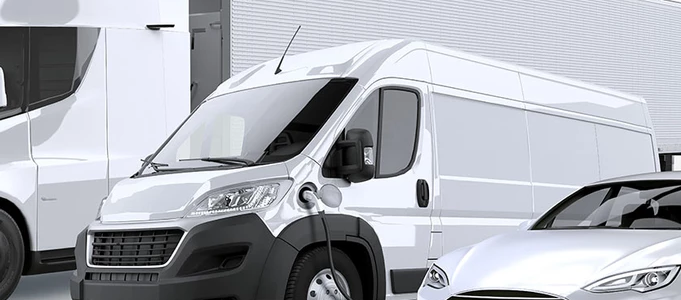The Benefits of Creating a Vehicle Maintenance Policy
A vehicle maintenance policy can help keep vehicles in good working order, no matter your fleet size. Having a robust set of policies is a best practice for fleet management as it has many benefits: supporting uptime, improving productivity over time, and optimizing resale value.
A written policy can also help promote a culture of safety among your drivers and other employees. Clear rules and procedures encourage others to look for and act on vehicle issues, protect themselves and others in the process, as well as reduce vehicle wear. A policy also provides important documentation in the unfortunate event of a collision or mechanical failure.
Here are three core reasons for setting up a fleet maintenance policy:
Duty of Care
This is the legal obligation of an organization or a person to avoid acts or omissions that are likely to cause harm to others. Having a well-communicated maintenance policy and program means an organization with fleets only sustains suitable, well-functioning vehicles by systematically maintaining and repairing them. Fleet managers should always be able to show a consistent history of compliance and enforcement.
Driver Safety
Creating a written vehicle maintenance policy helps to promote a culture of safety for drivers. Keeping a fleet in good working order helps mitigate driver risk, so that employees are not stranded with a broken down vehicle. Being consistent and specific is key.
Risk Mitigation
In too many fleets, maintenance is left up to the drivers, and there is little formal documentation on proper fleet maintenance procedures. A written policy that details all proactive efforts towards maintenance scheduling, record keeping and driver training can help. The end result is decreased risk and increased driver confidence by keeping vehicles in good working order.
How Can Fleet Technology Help?
Geotab and its Marketplace have many tools to help you stay on track with maintenance scheduling and understanding engine health, fuel levels, EV charging, and much more. Give Advantage Asset Tracking a call to learn more about how to create a vehicle maintenance policy and how to best utilize the Geotab Marketplace.
Growing Adoption of Telematics and Data Services in the Fleet Market
The 2020 Commercial Fleet Telematics and Data Analytics report, a series of forward-looking fleet technology publications from Escalent’s Fleet Advisory Hub, reveals that just 15% of fleets surveyed have adopted telematics solutions—primarily due to regulations (such as with trucking and transportation in response to Electronic Logging Devices mandates) or larger fleets looking to leverage economies of scale for increased return on their investments.
While the report shows a low market penetration, close to half (44%) of fleet decision-makers are actively shopping for telematics solutions—including 55% of those leading operations with 6–50 vehicles. Many decision-makers who have not yet adopted a solution are considering how to prepare their business for integration. The relatively low rate of adoption, in conjunction with a comparatively high rate of active shoppers and a general openness to the technology, reveals a market poised to explode.
Importance of Telematics Increases with Experience
Exhibiting value is key to driving adoption. Recognition of the importance of telematics’ role in managing the business nearly triples when knowledge of telematics solutions improves. Remarkably, 90% of fleet leaders with hands-on telematics experience rate the technology as “extremely important” or “somewhat important” to managing their business, according to the report. That’s an excellent sign that bodes well for the future of the market as long as providers bridge the experience gap and find ways to demonstrate the value of their products, both before and during implementation.
How We are Making a Difference
Advantage Asset Tracking has found bold and innovative ways to connect and communicate with prospective adopters. We capitalize on growth opportunities in this space by demonstrating our commitment to the success of our customers’ business. We strive to be excellent educators when describing specific features and work hard to establish personal relationships that allow us to evolve into a trusted advisor role. Our tangible use cases and coaching offer decision makers with evidence of how a data-driven management model can increase ROI the longer they stick with a telematics solution.
Can My Fleet Go Electric? ( Part 3 of 3 )
Our most recent blog posts focused on the electrification of today’s commercial fleets, a very trending topic in the world of fleets today. While the potential of minimizing CO2 emissions that impact the environment is enough of an incentive for fleet managers to make the conversion to EVs, the reality is that cost and operational capability challenges still impede them from making EVs suitable replacements for their internal combustion engine (ICE) vehicles.
In our first blog we talked about Geotab’s EV Suitability Assessment (EVSA) tool which allows users to analyze the historical data of their fleet vehicles to isolate the vehicles that could potentially be swapped out for EVs. In today’s blog post we cover the last consideration that should be made by fleet managers when exploring the question of whether their fleet can go electric.
Savings on fuel vs electric charging
Fleet managers should be aware that EV deployment and support will be an ongoing effort requiring synergy and buy-in from every level of their organization. They will need to collaborate with drivers to identify best practices that will work for everyone as well as keep their colleagues up to speed on the progress being made.
The most common questions fleets managers will likely get from their partners regarding EVs are going to be related to costs and return on investment (ROI). The best metrics to point to will depend on the objectives and timelines their company established at the outset, but a common short-term example to look at is savings on fuel vs electric charging. Geotab’s Fuel and EV Energy Usage Report will summarize the fleet’s fuel and electricity usage in one report for seamless analysis. The report will default to showing EV energy economy in MPG-e (miles per gallon equivalent) for easy comparison across EV and ICE vehicles. There are also a variety of measurements to choose from, such as Km/kWh, depending on preference.
Benefits of electrification
The learning curve may be steep, and changing habits may be difficult at first, but as long as the mission is clearly defined at the outset, and everyone on the team understands their important role, the benefits of electrification will soon start to outweigh the growing pains. Utilizing EVs puts a fleet on the forefront of a revolutionary change that will improve the business’s bottom line in the long run and dramatically enhance the brand’s image immediately.
In our post series on fleet electrification we have just scratched the surface of some of the ways Geotab is enabling fleets to embrace the new wave of EV technology that will continue to grow rapidly. Geotab will continue to collaborate with EV manufactures and introduce new features as part of the commitment to be a world leader in EV telematics service and support.
Are you interested in fleet electrification? Get in touch with Advantage Asset Tracking today to learn how you can make the transition to an EV fleet!
Can My Fleet Go Electric? ( Part 2 of 3 )
In our last blog post about converting conventional fleets into electric vehicles (EVs) we learned that many fleets are made up of a wide range of vehicle types with varying duty cycles, making it challenging to identify the vehicles that could be substituted. Fortunately, Geotab’s EV Suitability Assessment (EVSA) tool allows users to analyze the historical data of their fleet vehicles to isolate the vehicles that could potentially be swapped out for EVs.
It’s important to note that you don’t need to be all in or out with EVs when exploring a fleet transition. Using a phased approach that utilizes pure battery powered vehicles as well as plug-in hybrid electric vehicles (PHEVs) will make the process feel much more achievable and allow for a controlled rollout that mitigates disruptions.
Determining which fleet vehicles can be electrified and acquiring suitable replacements is a big first step, and the start of a transformative journey that will strengthen teamwork and boost your organization’s public image. Geotab has a number of ways that can help fleet managers optimize EV performance. Some of the key beneficial features include:
-
Plug-in reminders: Users can create rules so that if a vehicle enters an area with a charging station available when their EV is below a certain charge, they can receive a reminder or audible alert in the cab of the vehicle instructing them to plug-in and charge up. Conversely, if drivers are exiting an area where there are charging stations available, they can be notified to ensure they plan accordingly.
-
Charge statuses: Fleet managers can view the real time charge level of their EVs and if any of them are currently charging on the map view. EVs can be listed out with the charge level in descending order so fleet managers can easily hone in on vehicles with a low charge and reach out to the driver.
-
Charging summaries: Reports are an important tool for managers to gauge how their fleets are doing. The Geotab database can customize EV data for reports as it does with other collected data and will provide some standardized reports to help recap charging events, or lack thereof. Geofenced zones and vehicles movement can be utilized to ensure EVs are being charged whenever possible and flag events where charging opportunities were missed in a EV Charging Report. This can be a valuable coaching tool to help drivers adjust to the new process.
-
Live Alerts Dashboard: Ideally, fleet managers should have the opportunity to anticipate issues before they arise. Geotab’s Live Alerts Dashboard displays the current charge state of electrified fleet vehicles that can be displayed on a screen in a common area so that everyone on the team knows what they’re working with at the start of the day.
Are you interested in fleet electrification?
Stay tuned for our next blog on the topic or get in touch with Advantage Asset Tracking today to learn how you can make the transition to an EV fleet!
Can My Fleet Go Electric? ( Part 1 of 3 )
Electric vehicles (EVs) are becoming increasingly common personal vehicles with the potential of minimizing our CO2 emission impact on the environment. If EVs are ever going to fully realize this objective, however, they will need to also become common commercial vehicles.
The reality is that challenges, such as cost and operational capability, still remain for fleet managers to make EVs suitable replacements for their internal combustion engine (ICE) vehicles. But while EVs are still out of reach for some heavy-duty fleets, they have proven to be an effective, and even more economical option for some light duty fleets in terms of total cost of ownership (TCO).
So how can you accurately assess if your conventional fleet is ready to convert to electric?
For one, uniform fleets consisting of similar vehicle types with commonly shared duty cycles are ideal for analyzing the potential to electrify because their “one size fits all” vehicle sourcing makes it easy to try out a small sample of EVs and then assess the feasibility of a fleet wide deployment. Since many fleets are made up of a wide range of vehicle types with varying duty cycles, identifying the vehicles that could be substituted for EVs will be challenging for most.
Geotab’s EV Suitability Assessment (EVSA) tool allows users to analyze the historical data of their fleet vehicles to isolate the vehicles that could potentially be swapped out for EVs. In addition to utilizing average daily driving distance as a key consideration when assessing the vehicles that could be swapped out for EVs, there are also more subtle factors that, in combination, can have a significant impact on a fleet’s ability to electrify. These include:
-
Temperature Range: Unlike ICE vehicles, EVs don’t produce incidental heat that can be used to warm the cab of the vehicle. Heating or cooling the cab in an EV requires more energy to be drawn from the battery, which can affect range capability. The Geotab EVSA tool will take the average temperatures in your fleet’s operational territory into account.
-
Vehicle Model: Compact vehicles are easier to replace with EVs because their lower weight means they will get more mileage out of an electric drive train than their heavier counterparts. The EVSA will factor in the types of vehicles your fleet requires in the assessment.
-
Budget: Though many organizations may want to make a push for electrification as part of their wider ethos, at the end of the day, the financial numbers need to make sense when running a business. The EVSA will outline the cost for purchasing or leasing various EVs and plug in hybrids compared to the ICE equivalents as a part of the assessment and summarize instances where the TCO of the EV may be lower. The EVSA will also contrast the differences in annual CO2 tailpipe emissions between ICE vehicles and their EV counterparts should a company like to include these metrics in their budget.
Are you interested in fleet electrification?
Stay tuned for our next blog on the topic or get in touch with Advantage Asset Tracking today to learn how you can make the transition to an EV fleet!






